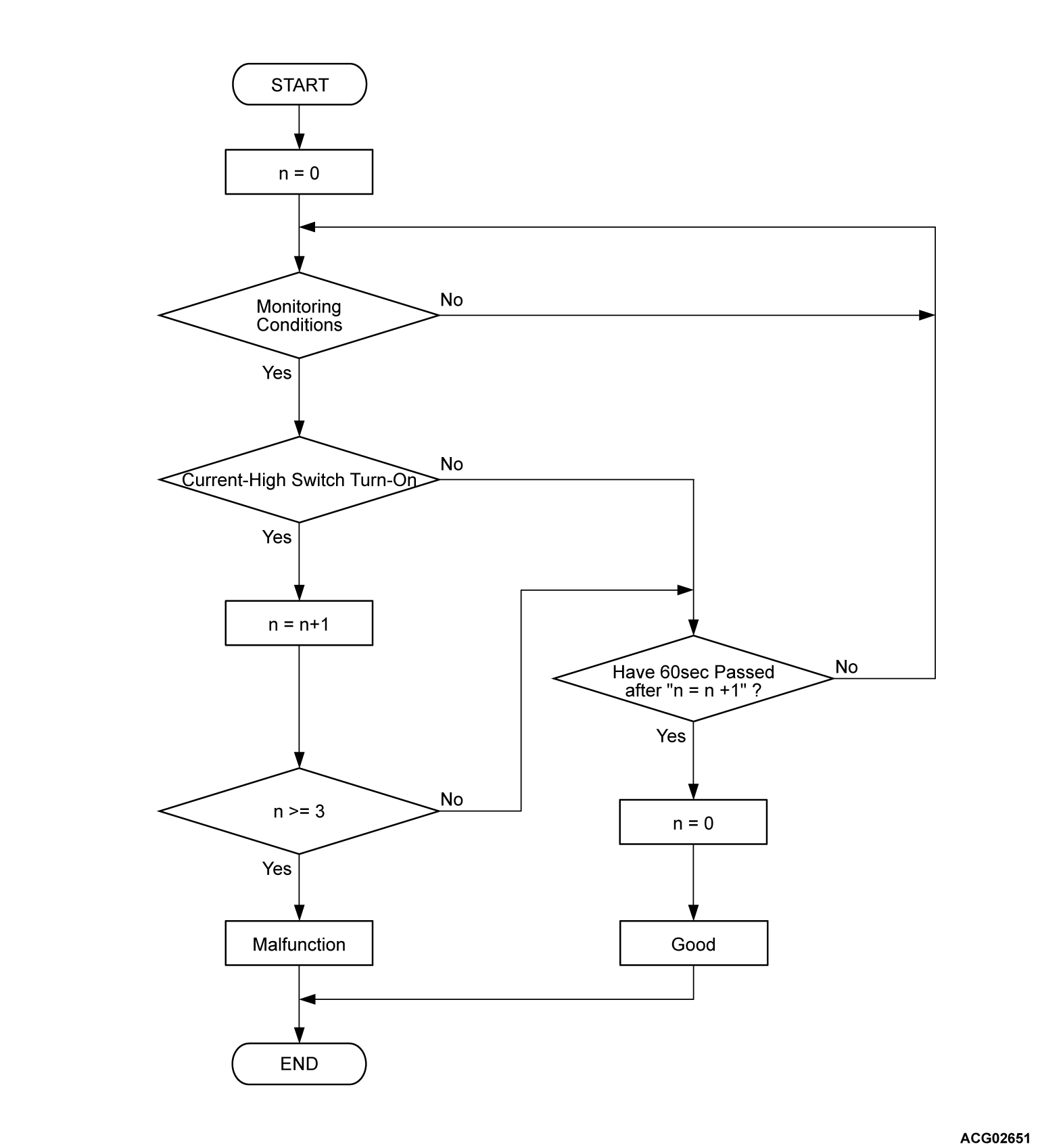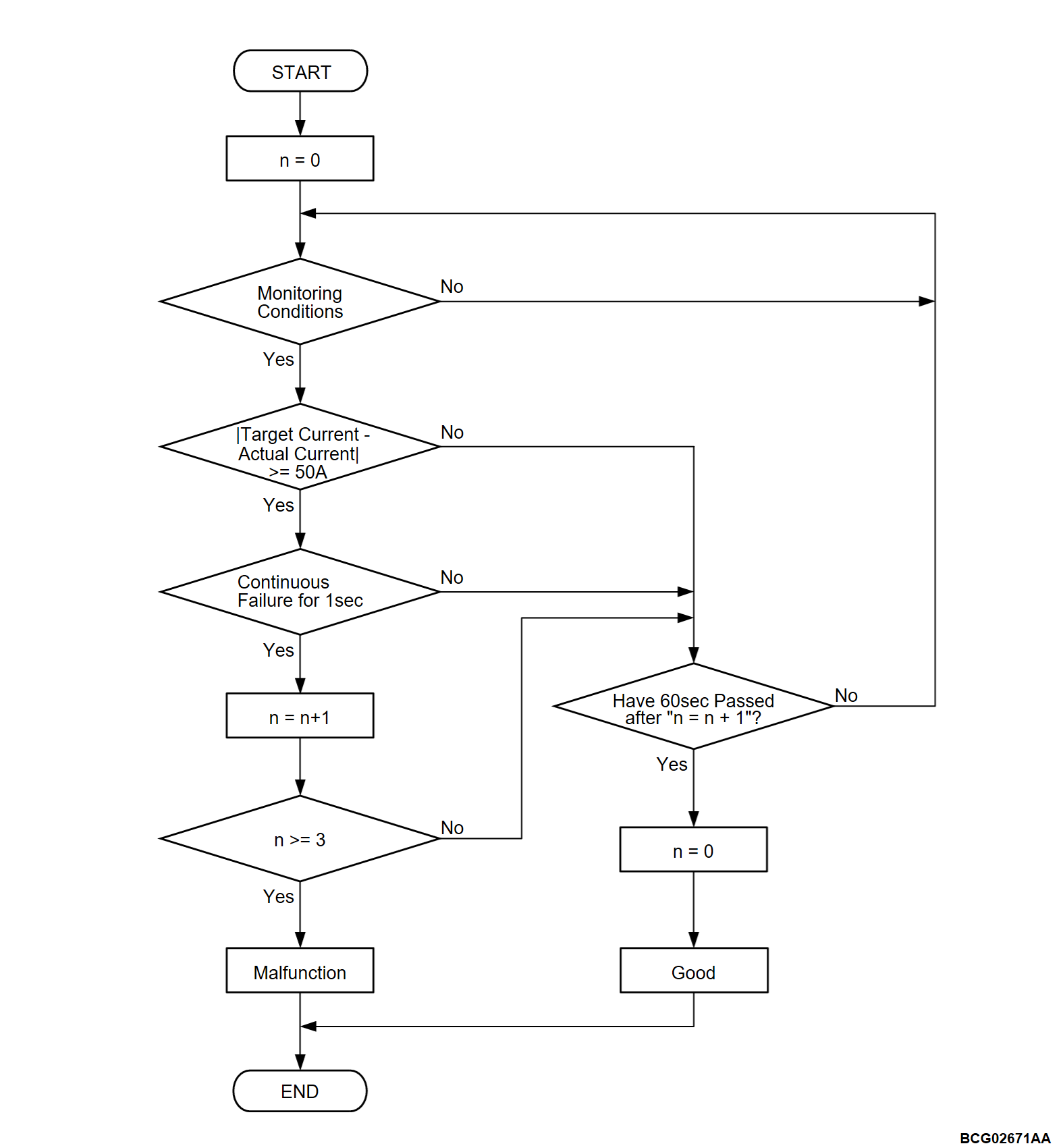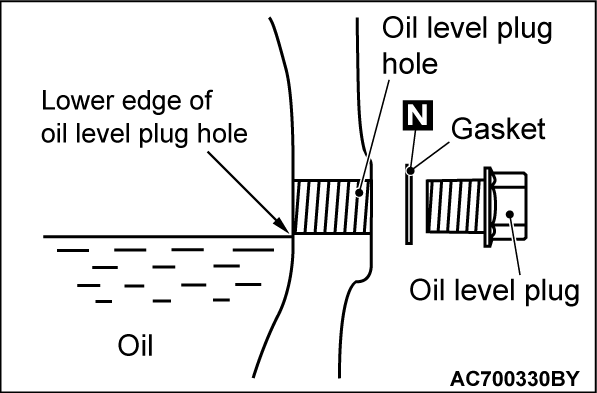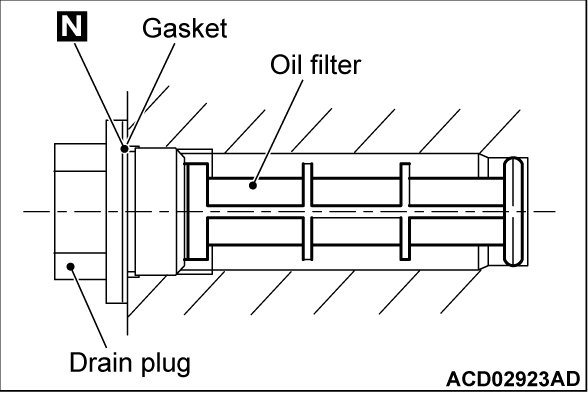DTC P1011: Generator overcurrent
DTC P104F: Three-phase line fails
DTC P104F: Three-phase line fails
| danger |
DESCRIPTIONS OF MONITOR METHODS <DTC P1011>
- Phase U and W coil current is directly measured while phase V current is calculated.
- When the maximum of three phase current exceeds 700 ampere the IGBT will temporarily shutdown for 0.2 second.
DESCRIPTIONS OF MONITOR METHODS <DTC P104F>
- Phase U and W coil current is directly measured and compared to the target current.
- An open/short circuit in the three phase motor is detected by comparing actual current of phase U and phase W of each motor to the target current which is calculated from the PHEV-ECU torque request.
MONITOR EXECUTION
- Continuous
MONITOR EXECUTION CONDITIONS (Other monitor and Sensor)
Other Monitor (There is no temporary DTC stored in memory for the item monitored below)
- Not applicable
Sensor (The sensor below is determined to be normal)
- Not applicable
DTC SET CONDITIONS
Check Conditions <DTC P1011>
- The IGBT status of power drive unit (GCU) is on (Active).
Judgment Criterion <DTC P1011>
- The generator current-high switch is turned ON 3 times within 60 seconds.
Check Conditions <DTC P104F>
- The IGBT status of power drive unit (GCU) is on (Active).
Judgment Criterion <DTC P104F>
- The absolute value of the difference between the value of target current and the value of actual current is 50 amperes or more for 3 times within 60 seconds.
PROBABLE CAUSES
- Three-phase wire in the high-voltage wiring harness fails
- Oil filter clogging
- Pipe clogging
- Malfunction of the generator
- Malfunction of the power drive unit [generator control unit (GCU)]
- Resolver wiring harness fails
- Malfunction of the front transaxle assembly
DIAGNOSIS
Required Special Tools
- MB991223: Wiring harness set
- MB992006: Extra fine probe
STEP 1. Using scan tool (M.U.T.-IIISE), check whether the DTC is set.
Check if the DTC P0A4B is set in the power drive unit (FEMCU).
Is the DTC set?
STEP 2. Check the generator.
Start the engine with battery charge mode to check whether there is abnormal sound or rotation trouble.
(1) Turn on the electric motor switch.
(2) Erase the DTC.
(3) Turn off the electric motor switch.
(4) Set the READY indicator to the on state.
(5) Press the battery charge switch to start the engine with battery charge mode.
| note | When the main drive lithium-ion battery is fully-charged, the engine does not start. Therefore, carry out under the condition that the battery charge is reduced. If the DTC is set, the engine does not start at all. |
Is the check result normal?
STEP 3. Using scan tool (M.U.T.-IIISE), check whether the DTC is set.
Check whether the power drive unit [generator control unit (GCU)] set a DTC P105C, P105B or P10AE which is related to the electric oil pump.
Is the DTC set?
STEP 4. Check the oil level.
Check that the oil level is at the lower edge of the oil level plug hole.
Is the check result normal?
STEP 5. Oil filter check
Remove the generator drain plug, check that the oil filter behind it is not clogged or damaged. Replace the front motor assembly (Refer to
Replace the front motor assembly (Refer to  ), the generator (Refer to
), the generator (Refer to  ), the Oil (Refer to GROUP 14B - On-Vehicle Service <Oil Cooling System> - Oil Change
), the Oil (Refer to GROUP 14B - On-Vehicle Service <Oil Cooling System> - Oil Change  ), the EV oil cooler hose (Refer to GROUP 14B - Oil Hose and Pipe
), the EV oil cooler hose (Refer to GROUP 14B - Oil Hose and Pipe  ) and the front transaxle assembly (Refer to GROUP 22A - Transaxle Assembly
) and the front transaxle assembly (Refer to GROUP 22A - Transaxle Assembly  ). Then go to Step 12
). Then go to Step 12 .
. Replace the EV oil cooler hose and EV oil cooler pipe (Refer to GROUP 14B - Oil Hose and Pipe
Replace the EV oil cooler hose and EV oil cooler pipe (Refer to GROUP 14B - Oil Hose and Pipe  ), the EV oil cooler bypass valve and electric oil pump (Refer to GROUP 14B - Electric Oil Pump/EV Oil Cooler Bypass Valve
), the EV oil cooler bypass valve and electric oil pump (Refer to GROUP 14B - Electric Oil Pump/EV Oil Cooler Bypass Valve  ), the front motor assembly (Refer to
), the front motor assembly (Refer to  ), the Oil (Refer to GROUP 14B - On-Vehicle Service <Oil Cooling System> - Oil Change
), the Oil (Refer to GROUP 14B - On-Vehicle Service <Oil Cooling System> - Oil Change  ), the generator (Refer to
), the generator (Refer to  ) and the front transaxle assembly (Refer to GROUP 22A - Transaxle Assembly
) and the front transaxle assembly (Refer to GROUP 22A - Transaxle Assembly  ). Then go to Step 12
). Then go to Step 12 .
.
Is the check result normal?
 Replace the front motor assembly (Refer to
Replace the front motor assembly (Refer to  ), the generator (Refer to
), the generator (Refer to  ), the Oil (Refer to GROUP 14B - On-Vehicle Service <Oil Cooling System> - Oil Change
), the Oil (Refer to GROUP 14B - On-Vehicle Service <Oil Cooling System> - Oil Change  ), the EV oil cooler hose (Refer to GROUP 14B - Oil Hose and Pipe
), the EV oil cooler hose (Refer to GROUP 14B - Oil Hose and Pipe  ) and the front transaxle assembly (Refer to GROUP 22A - Transaxle Assembly
) and the front transaxle assembly (Refer to GROUP 22A - Transaxle Assembly  ). Then go to Step 12
). Then go to Step 12 .
. Replace the EV oil cooler hose and EV oil cooler pipe (Refer to GROUP 14B - Oil Hose and Pipe
Replace the EV oil cooler hose and EV oil cooler pipe (Refer to GROUP 14B - Oil Hose and Pipe  ), the EV oil cooler bypass valve and electric oil pump (Refer to GROUP 14B - Electric Oil Pump/EV Oil Cooler Bypass Valve
), the EV oil cooler bypass valve and electric oil pump (Refer to GROUP 14B - Electric Oil Pump/EV Oil Cooler Bypass Valve  ), the front motor assembly (Refer to
), the front motor assembly (Refer to  ), the Oil (Refer to GROUP 14B - On-Vehicle Service <Oil Cooling System> - Oil Change
), the Oil (Refer to GROUP 14B - On-Vehicle Service <Oil Cooling System> - Oil Change  ), the generator (Refer to
), the generator (Refer to  ) and the front transaxle assembly (Refer to GROUP 22A - Transaxle Assembly
) and the front transaxle assembly (Refer to GROUP 22A - Transaxle Assembly  ). Then go to Step 12
). Then go to Step 12 .
.STEP 6. Using scan tool (M.U.T.-IIISE), check the actuator test.
| caution | When ambient temperature is -15°C (5°F) or less, the oil pump may not operate stably. Execute the actuator test only when the temperature is above -15°C (5°F). |
(2) Check for the existence of oil leakage.
Is the oil level appropriate?
STEP 7. Check the high-voltage terminal.
| danger |
|
(2) Check that the following cable (power drive unit side) is tightened to the specified torque.
Is the check result normal?
STEP 8. Check the power drive unit [generator control unit (GCU)] connector
Check the power drive unit connector (GS1 line, GS2 line, GS3 line, GS4 line, GR1 line and GR2 line) visually for semi-fitting, damage, moisture/foreign matter intrusion.
Is the check result normal?
: Replace the wiring harness (GS1 line, GS2 line, GS3 line, GS4 line, GR1 line and GR2 line). Then go to Step 12 .
.
 .
.STEP 9. Check the resistance in the resolver.
(1) Disconnect the power drive unit connectors.
(2) Measure the resistance between the generator connector terminals.
|
Is the check result normal?
STEP 10. Measure resistance between the power drive unit connector and the generator connector (GS1 line, GS2 line, GS3 line, GS4 line, GR1 line and GR2 line)
(1) Remove the wiring harness (GS1 line, GS2 line, GS3 line, GS4 line, GR1 line and GR2 line).
(2) Check the continuity of wring harness (GS1 line, GS2 line, GS3 line, GS4 line, GR1 line and GR2 line).
OK: Continuity exists (2 Ω or less)
Is the check result normal?
![[Previous]](../../../buttons/fprev.png)
![[Next]](../../../buttons/fnext.png)



